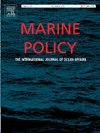Out of habitat marine mammals – Identification, causes, and management recommendations
IF 3.5
2区 社会学
Q2 ENVIRONMENTAL STUDIES
引用次数: 0
Abstract
An out of habitat (OOH) marine mammal is an individual found outside of their natural range, e.g., an Atlantic walrus (Odobenus rosmarus rosmarus) along the coastline of mainland Europe, or an individual within their natural range in habitat that is not optimal for their health or survival due to a lack of suitable conditions and/or because of potential conflict with humans. As the number of OOH marine mammals appears to be increasing, and following on from two international workshops, here we define what constitutes an OOH marine mammal and provide a detailed assessment of potential drivers. Climate change, habitat loss and/or degradation, disturbance, changes in prey distribution, and morbidity may all be reasons for a marine mammal being OOH. Appropriate management of OOH marine mammals is considered. This may simply involve monitoring to better understand the situation, to protect the welfare of the animal(s) and to ensure that members of the public are kept safe. However, on occasion, further intervention may be required, such as providing safe areas for the OOH marine mammal(s), encouraging the animal(s) to move, capture and translocation, or euthanasia. Regardless of the action taken, educating and communicating with the public are key elements of OOH marine mammal management. Lessons can be learned from human-wildlife conflict and rewilding scenarios. The potential for OOH marine mammals to be pioneers seeking new habitat, contributing to species resilience in the face of rapidly changing environments, and how to include them in conservation legislation and management planning are considered.
离开栖息地的海洋哺乳动物。鉴定、原因和管理建议
栖息地外(OOH)海洋哺乳动物是指在其自然活动范围之外发现的个体,例如,沿着欧洲大陆海岸线发现的大西洋海象(Odobenus rosmarus rosmarus),或者在其自然活动范围内的个体,由于缺乏合适的条件和/或由于与人类的潜在冲突而对其健康或生存不是最佳的栖息地。由于户外海洋哺乳动物的数量似乎在增加,在两个国际研讨会之后,我们在这里定义了什么是户外海洋哺乳动物,并提供了潜在驱动因素的详细评估。气候变化、栖息地丧失和/或退化、干扰、猎物分布的变化和发病率都可能是海洋哺乳动物户外活动的原因。考虑户外海洋哺乳动物的适当管理。这可能只涉及监测,以更好地了解情况,保护动物的福利,并确保公众的安全。然而,有时可能需要进一步的干预,例如为户外海洋哺乳动物提供安全区域,鼓励动物移动,捕获和转移,或安乐死。无论采取何种行动,教育和与公众沟通都是户外海洋哺乳动物管理的关键要素。我们可以从人类与野生动物的冲突和重新放野的场景中吸取教训。户外海洋哺乳动物有可能成为寻找新栖息地的先驱,在面对快速变化的环境时为物种恢复力做出贡献,以及如何将它们纳入保护立法和管理规划。
本文章由计算机程序翻译,如有差异,请以英文原文为准。
求助全文
约1分钟内获得全文
求助全文
来源期刊

Marine Policy
Multiple-
CiteScore
7.60
自引率
13.20%
发文量
428
期刊介绍:
Marine Policy is the leading journal of ocean policy studies. It offers researchers, analysts and policy makers a unique combination of analyses in the principal social science disciplines relevant to the formulation of marine policy. Major articles are contributed by specialists in marine affairs, including marine economists and marine resource managers, political scientists, marine scientists, international lawyers, geographers and anthropologists. Drawing on their expertise and research, the journal covers: international, regional and national marine policies; institutional arrangements for the management and regulation of marine activities, including fisheries and shipping; conflict resolution; marine pollution and environment; conservation and use of marine resources. Regular features of Marine Policy include research reports, conference reports and reports on current developments to keep readers up-to-date with the latest developments and research in ocean affairs.
 求助内容:
求助内容: 应助结果提醒方式:
应助结果提醒方式:


